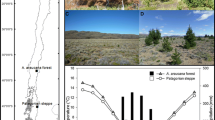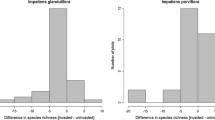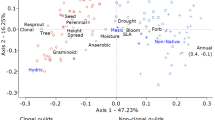Abstract
Pinus contorta, one of the most invasive tree species in the world, has been proposed as a model species for improving our understanding of invasion ecology. In this study, we assessed the impact of P. contorta invasions on the species richness, diversity and species traits of a resident treeless steppe community. In a Pinus contorta invasion gradient (Patagonia, Chile), we surveyed vegetation from high canopy closure pine invasion to treeless steppe, and computed species richness, diversity and Sørensen similarity indexes. For all species, we determined functional trait values from the literature, data bases, and personal observations. Species richness and diversity were related to canopy cover (a proxy for invasion intensity) using generalized linear mixed-effects models. Changes in species traits due to canopy cover were analyzed using RLQ ordination analysis and the fourth-corner analysis. We found that Pinus contorta canopy cover significantly reduced the number of native species by 70 %, implying a strong effect on species exclusion. A few native species, however, prevail in the novel conditions (e.g. Baccharis magellanica, Acaena integerrima). Species traits changed significantly with increasing pine canopy cover, where P. contorta promoted the existence of traits related to shade-tolerance and conservative reproductive strategies. We conclude that the negative impacts of Pinus contorta into the treeless steppe, including a reduction in the number of species and the shifting to traits adapted to tolerate shade and associated with conservative reproductive strategies, can have severe implications for the conservation of biodiversity and ecosystem functioning where it invades.




Similar content being viewed by others
References
Adler PB, Fajardo A, Kleinhesselink AR, Kraft NJB (2013) Trait-based tests of coexistence mechanisms. Ecol Lett 16:1294–1306
Alpert P, Bone E, Holzapfel C (2000) Invasiveness, invasibility and the role of environmental stress in the spread of non-native plants. Perspect Plant Ecol Evol Syst 3:52–66
Bates D and Maechler M (2009) lme4: Linear mixed-effects models using S4 classes. R package version 0.999375-31. http://CRAN.R-project.org/package=lme4
Bivand R, Lewin-Koh N, Pebesma E, Archer E, Baddeley A, Bibiko H-J, Brey S, Callahan J, Carrillo G, Dray S, Forrest D, Friendly M, Giraudoux P, Golicher D, Gómez Rubio V, Hausmann P, Hufthammer KO, Jagger T, Luque S, MacQueen D, Niccolai A, Lamigueiro OP, Short T, Snow G, Stabler B, Stokely M, Turner R (2015) Maptools: tools for reading and handling spatial objects. R package version 0.8–10. http://r-forge.r-project.org/projects/maptools/
Chabrerie O, Loinard J, Perrin S, Saguez R, Decocq G (2010) Impact of Prunus serotina invasion on understory functional diversity in a European temperate forest. Biol Invasions 12:1891–1907
Chao A, Chazdon RL, Colwell RK, Shen T-J (2005) A new statistical approach for assessing similarity of species composition with incidence and abundance data. Ecol Lett 8:148–159
Chessel D, Dufour A, Thioulouse J (2004) The ade4 package-I: one-table methods. R news 4:5–10
Colwell RK (2013) EstimateS: statistical estimation of species richness and shared species from samples. Version 9 and earlier. User’s Guide and application. http://viceroy.eeb.uconn.edu/estimates/index.html
Correa MV (1998) Flora patagónica, Parte I. INTA, Buenos Aires
Dolédec S, Chessel D, terBraak CJF, Champely S (1996) Matching species traits to environmental variables: a new three-table ordination method. Environ Ecol Stat 3:143–166
Dray S, Legendre P (2008) Testing the species traits-environment relationships: the fourth-corner problem revisited. Ecology 89:3400–3412
Dray S, Chessel D, Thioulouse J (2003) Co-inertia analysis and the linking of ecological data tables. Ecology 84:3078–3089
Dray S, Choler P, Dolédec S, Peres-Neto PR, Thuiller W, Pavoine S, ter Braak CJF (2014) Combining the fourth-corner and the RLQ methods for assessing trait responses to environmental variation. Ecology 95:14–21
Fajardo A, Gundale MJ (2015) Combined effects of anthropogenic fires and land–use change on soil properties and processes in Patagonia, Chile. For Ecol Manag 357:60–67
Fajardo A, McIntire EJB (2010) Merged trees in second-growth, fire origin forests in Patagonia, Chile: positive spatial association patterns and their ecological implications. Am J Bot 97:1424–1430
Frazer GW, Canham CD, Lertzman KP (2000) Gap light analyzer (GLA), Version 2.0: image processing software to analyze true-colour, hemispherical canopy photographs. Bull Ecol Soc Am 81:191–197
Fuentes N, Pauchard A, Sánchez P, Esquivel J, Marticorena A (2013) A new comprehensive database of alien plant species in Chile based on herbarium records. Biol Invasions 15:847–858
Grotkopp E, Rejmánek M, Rost TL (2002) Toward a causal explanation on plant invasiveness: seedling growth and life-history strategies of 29 pine (Pinus) species. Am Nat 159:396–419
Gundale MJ, Pauchard A, Langdon B, Peltzer DA, Maxwell BD, Nuñez MA (2014) Can model species be used to advance the field of invasion ecology? Biol Invasions 16:591–607
Hayward J, Horthon TR, Pauchard A, Nuñez MA (2015) A single ectomycorrhizal fungal species can enable a Pinus invasion. Ecology 96:1438–1444
Hess LJT, Austin AT (2014) Pinus ponderosa alters nitrogen dynamics and diminishes the climate footprint in natural ecosystems of Patagonia. J Ecol 102:610–621
Hooper DU, Dukes JS (2010) Functional composition controls invasion success in a California serpentine grassland. J Ecol 98:764–777
Langdon B, Pauchard A, Aguayo M (2010) Pinus contorta invasion in the Chilean Patagonia: local patterns in a global context. Biol Invasions 12:3961–3971
Ledgard N (2001) The spread of lodgepole pine (Pinus contorta, Dougl.) in New Zealand. For Ecol Manag 141:43–57
Legendre P, Galzin R, HarmelinVivien ML (1997) Relating behavior to habitat: solutions to the fourth-corner problem. Ecology 78:547–562
Levine JM, Vila M, D’Antonio CM, Dukes JS, Grigulis K, Lavorel S (2003) Mechanisms underlying the impacts of exotic plant invasions. Proc R Soc B Biol Sci 270:775–781
Lockwood JL, Cassey P, Blackburn T (2005) The role of propagule pressure in explaining species invasions. Trends Ecol Evol 20:223–228
Löewe V, Murillo P (2001) Estudio de ensayo de introducción de especies. INFOR, Santiago
Luebert F, Pliscoff P (2006) Sinopsis bioclimática y vegetacional de Chile. Editorial Universitaria, Santiago, p 316
MacArthur R, Levins R (1967) The limiting similarity, convergence, and divergence of coexisting species. Am Nat 101:377–385
MacDougall AS, Gilbert B, Levine JM (2009) Plant invasions and the niche. J Ecol 97:609–615
McCune B, Grace JB (2002) Analysis of ecological communities. MjM Software Design, Glededen Beach, p 300
Mulder CPH, Bazeley-White E, Dimitrakopoulos PG, Hector A, Scherer-Lorenzen M, Schmid B (2004) Species evenness and productivity in experimental plant communities. Oikos 107:50–63
Oksanen J, Blanchet FG, Kindt R, Legendre P, Minchin PR, O’Hara RB, Simpson GL, Solymos P, Stevens MHH and Wagner H (2013) vegan: community ecology package. R package version 2.0-10, http://CRAN.R-project.org/package=vegan
Pauchard A, Escudero A, García RA, de la Cruz M, Langdon B, Cavieres LA, Esquivel J (2016) Pine invasions in treeless environments: dispersal overruns microsite heterogeneity. Ecol Evol 6:447–459
Peña E, Hidalgo M, Langdon B, Pauchard A (2008) Patterns of spread of Pinus contorta Dougl. ex Loud. invasion in a natural reserve in southern South America. For Ecol Manag 256:1049–1054
Powell KI, Chase JM, Knight TM (2011) A synthesis of plant invasion effects on biodiversity across spatial scales. Am J Bot 98:539–548
R-Development-Core-Team (2013) R: a language and environment for statistical computing. Version, 2.15.3. R Foundation for Statistical Computing. ISBN 3-900051-07-0, http://www.R-project.org
Rejmánek M, Rosén E (1992) Influence of colonizing shrubs on species-area relationships in alvar plant communities. J Veg Sci 3:625–630
Richardson DM (1998) Forestry trees as invasive aliens. Conserv Biol 12:18–26
Richardson DM, Rejmanek M (2004) Conifers as invasive aliens: a global survey and predictive framework. Divers Distrib 10:321–331
Richardson DM, Rejmánek M (2011) Trees and shrubs as invasive alien species—a global review. Divers Distrib 17:788–809
Richardson DM, Williams PA, Hobbs RJ (1994) Pine invasions in the Southern Hemisphere: determinants of spread and invadability. J Biogeogr 21:511–527
Rodríguez R, Marticorena A, Teneb E (2008) Vascular plants of Baker and Pascua Rivers, Region of Aisen, Chile. Gayana Botanica 65:39–70
Rundel PW, Dickie IA, Richardson DM (2014) Tree invasions into treeless areas: mechanisms and ecosystem processes. Biol Invasions 16:663–675
Scheu R, Ahumada M, Cerda J, Silva F and Cruces P (2008) Guias de condición para los pastizales de la ecorregión esteparia fría de Aysén, Proyecto FNDR—SAG XI Región de Aysén: Levantamiento para el ordenamiento de los Ecosistemas de Aysén. Servicio Agrícola y Ganadero (SAG), Región de Aysén. Ministerio de Agricultura, Gobierno de Chile, 94 pp
Silva F (2010) Flora Agropecuaria de Aysén, Ministerio de Agricultura de Chile, Servicio Agrícola y Ganadero. Región de Aysén. Primera edición, 520 pp
Simberloff D, Nunez MA, Ledgard NJ, Pauchard A, Richardson DM, Sarasola M, Van Wilgen BW, Zalba SM, Zenni RD, Bustamante R, Peña E, Ziller SR (2010) Spread and impact of introduced conifers in South America: lessons from other Southern Hemisphere regions. Aust Ecol 35:489–504
Taylor KT, Maxwell BD, Pauchard A, Nuñez MA, Peltzer DA, Terwei A, Rew LJ (2016a) Drivers of plant invasion vary globally: evidence from pine invasions within six ecoregions. Glob Ecol Biogeogr 25:96–106
Taylor KT, Maxwell BD, Pauchard A, Nuñez MA, Rew LJ (2016b) Native versus nonnative invasions: similarities and differences in the biodiversity impacts of Pinus contorta in introduced and native ranges. Div Distrib press. doi:10.1111/ddi.12419
Teillier S, Macaya-Berti J, Bonnemaison C, Delaunoy J, Marticorena A (2013) A contribution to the knowledge of the flora of Huilo Huilo biological reserve, Región de Los Ríos, Chile. Gayana Botanica 70:194–234
Thuiller W, Gassó N, Pino J, Vilà M (2012) Ecological niche and species traits: key drivers of regional plant invader assemblages. Biol Invasions 14:1963–1980
Török P, Miglécz P, Valkó P, Tóth K, Kelemen A, Albert Á-J, Matus G, Molnár V, Ruprecht E, Papp L, Deák B, Horváth O, Takács A, Hüse B, Tóthmérész B (2013) New thousand-seed weight records of the Pannonian flora and their application in analysing social behaviour types. Acta Botanica Hungarica 55:429–472
Underwood AJ (1997) Experiments in ecology: their logical design and interpretation using analysis of variance. Cambridge University Press, Cambridge
Vilà M, Espinar JL, Hejda M, Hulme PE, Jarošik V, Maron JL, Pergl J, Schaffner U, Sun Y, Pyšek P (2011) Ecological impacts of invasive alien plants: a meta-analysis of their effects on species, communities and ecosystems. Ecol Lett 14:702–708
Weiher E, Keddy PA (1995) Assembly rules, null models, and trait dispersion: new questions from old patterns. Oikos 74:159–164
Weiher E, van der Werf A, Thompson K, Roderick M, Garnier E, Eriksson O (1999) Challenging Theophrastus: a common core list of plant traits for functional ecology. J Veg Sci 10:609–620
Westoby M, Falster DS, Moles AT, Vesk PA, Wright IJ (2002) Plant ecological strategies: some leading dimensions of variation between species. Annu Rev Ecol Syst 33:125–159
Zhang Y, Chen JM, Miller JR (2005) Determining digital hemispherical photograph exposure for leaf area index estimation. Agric For Meteorol 133:166–181
Zuloaga F, Morrone O, Belgrano M, Marticorena C and Marchesi E (2008) Catálogo de las plantas vasculares del cono sur (Argentina, southern Brazil, Chile, Paraguay y Uruguay), Monographs of the Missouri Botanical Garden, 107. vol. 1 Pteridophyta, Gymnospermae y Monocotyledoneae; vol. 2 Dicotyledoneae: A-F; vol. 3 Dicotyledoneae: F-Z, 3348 pp
Acknowledgments
This study has been financed by the Chilean Fondo Nacional de Desarrollo Científico y Tecnológico (FONDECYT) project 1120171 to AF and PBM. Additional support to PBM and AP came from Grants ICM P05–002 and CONICYT PFB–23.
Author information
Authors and Affiliations
Corresponding author
Electronic supplementary material
Below is the link to the electronic supplementary material.
Rights and permissions
About this article
Cite this article
Bravo-Monasterio, P., Pauchard, A. & Fajardo, A. Pinus contorta invasion into treeless steppe reduces species richness and alters species traits of the local community. Biol Invasions 18, 1883–1894 (2016). https://doi.org/10.1007/s10530-016-1131-4
Received:
Accepted:
Published:
Issue Date:
DOI: https://doi.org/10.1007/s10530-016-1131-4




